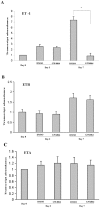Inhibition of endothelin-1-mediated contraction of hepatic stellate cells by FXR ligand
- PMID: 21085652
- PMCID: PMC2978707
- DOI: 10.1371/journal.pone.0013955
Inhibition of endothelin-1-mediated contraction of hepatic stellate cells by FXR ligand
Abstract
Activation of hepatic stellate cells (HSCs) plays an important role in the development of cirrhosis through the increased production of collagen and the enhanced contractile response to vasoactive mediators such as endothelin-1 (ET-1). The farnesoid X receptor (FXR) is a member of the nuclear receptor superfamily that is highly expressed in liver, kidneys, adrenals, and intestine. FXR is also expressed in HSCs and activation of FXR in HSCs is associated with significant decreases in collagen production. However, little is known about the roles of FXR in the regulation of contraction of HSCs. We report in this study that treatment of quiescent HSCs with GW4064, a synthetic FXR agonist, significantly inhibited the HSC transdifferentiation, which was associated with an inhibition of the upregulation of ET-1 expression. These GW4064-treated cells also showed reduced contractile response to ET-1 in comparison to HSCs without GW4064 treatment. We have further shown that GW4064 treatment inhibited the ET-1-mediated contraction in fully activated HSCs. To elucidate the potential mechanism we showed that GW4064 inhibited ET-1-mediated activation of Rho/ROCK pathway in activated HSCs. Our studies unveiled a new mechanism that might contribute to the anti-cirrhotic effects of FXR ligands.
Conflict of interest statement
Figures







Similar articles
-
Increased contractility of hepatic stellate cells in cirrhosis is mediated by enhanced Ca2+-dependent and Ca2+-sensitization pathways.Am J Physiol Gastrointest Liver Physiol. 2011 Jun;300(6):G1010-21. doi: 10.1152/ajpgi.00350.2010. Epub 2011 Mar 10. Am J Physiol Gastrointest Liver Physiol. 2011. PMID: 21393429
-
Disruption of TFGβ-SMAD3 pathway by the nuclear receptor SHP mediates the antifibrotic activities of BAR704, a novel highly selective FXR ligand.Pharmacol Res. 2018 May;131:17-31. doi: 10.1016/j.phrs.2018.02.033. Epub 2018 Mar 9. Pharmacol Res. 2018. PMID: 29530598
-
Salvianolic acid B lowers portal pressure in cirrhotic rats and attenuates contraction of rat hepatic stellate cells by inhibiting RhoA signaling pathway.Lab Invest. 2012 Dec;92(12):1738-48. doi: 10.1038/labinvest.2012.113. Epub 2012 Sep 17. Lab Invest. 2012. PMID: 22986787
-
Roles of nuclear receptors in hepatic stellate cells.Expert Rev Gastroenterol Hepatol. 2021 Aug;15(8):879-890. doi: 10.1080/17474124.2021.1949288. Epub 2021 Jul 7. Expert Rev Gastroenterol Hepatol. 2021. PMID: 34225534 Review.
-
Stellate cell contraction: role, regulation, and potential therapeutic target.Clin Liver Dis. 2008 Nov;12(4):791-803, viii. doi: 10.1016/j.cld.2008.07.004. Clin Liver Dis. 2008. PMID: 18984467 Free PMC article. Review.
Cited by
-
The role of hepatic microenvironment in hepatic fibrosis development.Ann Med. 2022 Dec;54(1):2830-2844. doi: 10.1080/07853890.2022.2132418. Ann Med. 2022. PMID: 36399108 Free PMC article. Review.
-
FXR and liver carcinogenesis.Acta Pharmacol Sin. 2015 Jan;36(1):37-43. doi: 10.1038/aps.2014.117. Epub 2014 Dec 15. Acta Pharmacol Sin. 2015. PMID: 25500874 Free PMC article. Review.
-
Translating an understanding of the pathogenesis of hepatic fibrosis to novel therapies.Clin Gastroenterol Hepatol. 2013 Mar;11(3):224-31.e1-5. doi: 10.1016/j.cgh.2013.01.005. Epub 2013 Jan 7. Clin Gastroenterol Hepatol. 2013. PMID: 23305825 Free PMC article. Review.
-
Pharmacologic Modulation of Bile Acid-FXR-FGF15/FGF19 Pathway for the Treatment of Nonalcoholic Steatohepatitis.Handb Exp Pharmacol. 2019;256:325-357. doi: 10.1007/164_2019_228. Handb Exp Pharmacol. 2019. PMID: 31201553 Free PMC article. Review.
-
Establishment and characterization of an immortalized rat hepatic stellate cell line.Int J Clin Exp Pathol. 2015 Oct 1;8(10):12064-74. eCollection 2015. Int J Clin Exp Pathol. 2015. PMID: 26722391 Free PMC article.
References
-
- Blomhoff R, Wake K. Perisinusoidal stellate cells of the liver: important roles in retinol metabolism and fibrosis. FASEB J. 1991;5:271–277. - PubMed
-
- Rockey DC, Weisiger RA. Endothelin induced contractility of stellate cells from normal and cirrhotic rat liver: implications for regulation of portal pressure and resistance. Hepatology. 1996;24:233–240. - PubMed
Publication types
MeSH terms
Substances
Grants and funding
LinkOut - more resources
Full Text Sources
Other Literature Sources

